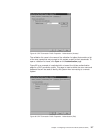where lib/file represents your own new file, such as QUSRSYS/SLIPSCRIPT.
This creates a new file that uses the existing default connection script file as the
base and that contains all of the same data. You can now change the data for your
use.
You must refer to the new connection script file name in the TCP/IP point-to-point
configuration profile that will use the new connection script.
If you need to use characters in your connection script file that are not supported by
EBCDIC CCSID 500, which is the CCSID of the default connection script, then go
to “NLS Considerations” on page 125.
Rules for Creating and Changing Connection Scripts
There are many special rules for creating and changing connection scripts. The
rules are as follows:
v Column 1 of each line in the connection script may contain a control character.
The control character specifies the action to be taken by AS/400 system. Column
2 may be left blank.
– The AS/400 system ignores comment lines.
Comment lines begin with either an asterisk (*), or are completely blank.
– Output lines for the remote system begin with an ampersand (&)
– To send an asterisk (*) to the remote host, put an ampersand (&) in column 1
followed by an asterisk in column 2.
To send an ampersand (&) to the remote host, put an ampersand in column 1
followed by an ampersand in column 2.
– A blank line with an ampersand in column 1 will not be sent to the remote
host. Refer to the (PROMPT) keyword for this operation.
v The AS/400 system interprets any non-blank line that does not contain one of the
previously described control characters as input from the remote host.
v You can mix upper-case and lower-case in a line that contains expected input
from the remote host.
AS/400 translates all input to upper-case before comparing the dialog match text.
v AS/400 expects each line of dialog text from the remote system to end with an
end-of-line character, such as a carriage return, New Line, or Line Feed. If this is
not possible, dialog match text may be changed to achieve a match. For
example, if the remote server host prompts for a password with ″Password:″,
then the match text in the connection script may be shortened to ″Pass″ or
″Password″ (the colon character has been omitted).
v Fields enclosed in parentheses () contain the keywords that describe an input or
an output operation.
You cannot define the keywords. However, you can control the operations
performed during the connection dialog. To control the operations and the order
in which they run, create a unique connection script using appropriately placed
keywords.
v You cannot change the default connection scripts.
If you need a connection script that is different from all the default ones, you
must copy the default connection scripts and change the copy.
The valid keywords are:
Chapter 4. Configuring Point-to-Point TCP/IP (PPP and SLIP) 119


















